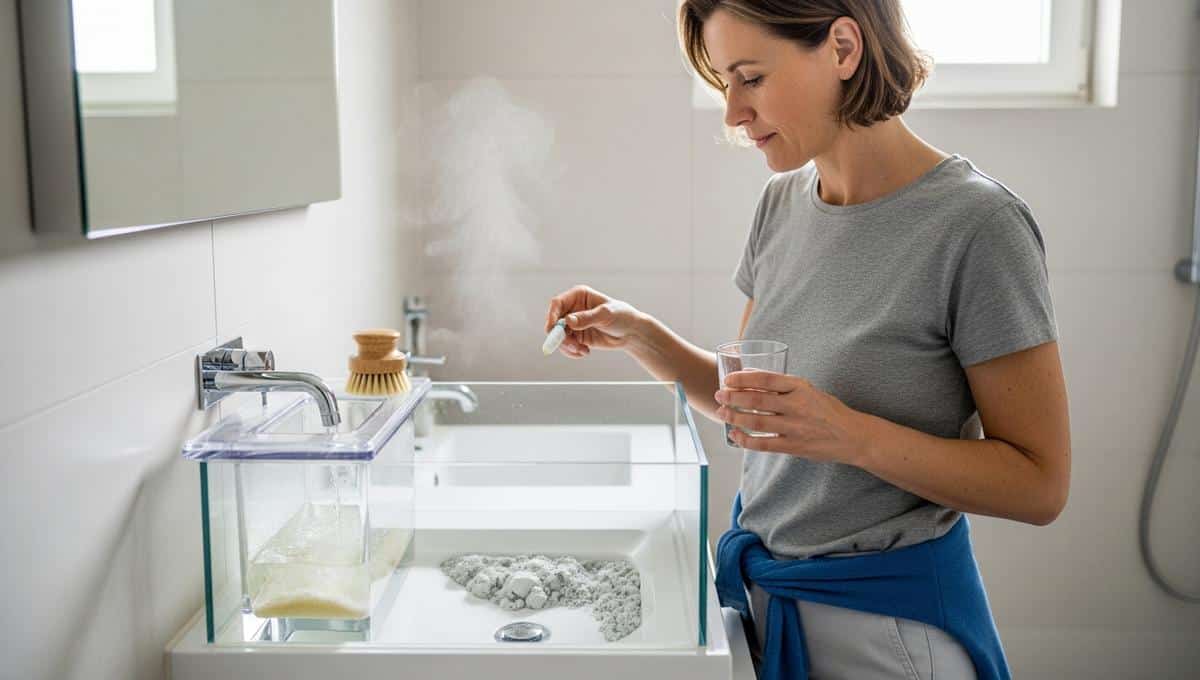Hard-water rings can feel like a losing battle. Yet there is a fast, bleach-free way to break down limestone in the toilet base. Here is how to act quickly, safely, and with a light footprint.
What really causes toilet limestone, and why it sticks
Mineral deposits grow where water sits and dries. In regions with high hardness, carbonate crystals bind to the glaze. As a result, the base becomes rough, which traps new soil. That is why limestone seems to return faster each week.
Bleach may whiten, yet it does not dissolve the stone. Vinegar can work, but odors and fumes are a pain. Instead, weak organic acids in warm water break bonds more effectively. Because deposits of limestone are porous, they soak the liquid.
The express method: citric acid, hot water, and a brush
Start with heat and citric acid for speed. Warm 1 liter of water to 70–80°C; do not boil. Then dissolve 2–3 tablespoons of citric acid and pour slowly at the bowl bottom. The warm bath clings to limestone and begins to chelate.
« Zero bleach, zero vinegar, quick results against scale. »
Next, wait 20–40 minutes; longer rest improves contact. Meanwhile, brush from the trap upward to move the solution. Rinse, then repeat once if a ring remains. For safety, wear gloves, since acids can irritate skin near limestone zones.
What to avoid, safer swaps, and timesaving tricks
Strong chlorine reacts with urine residues to form fumes. Therefore, skip bleach for indoor descaling. Skip pure vinegar too, since the smell lingers and results vary on dense limestone. Choose citric acid powder, which is food-safe and low-odor.
- Heat boosts action; target warm, not boiling water.
- Use clear doses: about 2–3 tbsp citric per liter.
- Give contact time: 20–40 minutes beats quick scrubs.
- Brush gently; let chemistry do most of the work.
- Ventilate the room and wear gloves for comfort.
Pollux — Pollux WC gel 750 ml (Produit nettoyant pour WC) can help with routine shine between deep treatments. Use it as directed to keep the bowl fresh while the heavy lifting is done by citric acid.
To readSoda crystals: 12 home uses to tackle tough stains and unclog drainsCoffee-machine descaler based on citrate works too in a pinch. However, check labels and avoid sulfamic blends on chrome trim. Baking soda is useful after the acid step to neutralize and deodorize. That sequence keeps limestone residues from spreading as you scrub.
Drain excess bowl water to raise solution strength. You can push water back with a swab or a quick cup. Consequently, more acid meets the stain for longer. That simple prep saves time when limestone sits in the trap bend.
For stubborn limestone rings: mechanical help and smart habits
When a grey ring persists, try a pumice stick on wet glaze. Gently rub only the deposit, and keep the surface wet. As needed, use a nylon pad for edges and under the rim. This combo lifts limestone that acids alone leave behind.
Hardness comes from your supply, not just cleaning gaps. Therefore, reduce standing water and flush after tank drips. If possible, fit an in-cistern dose of citrate or install a softener. Over time, less fresh limestone will form on the porcelain.
A simple routine to keep the bowl clear
Plan a quick cycle once a week. Pour 0.5 liter of warm citric solution into the base at night. Then brush in the morning for under 60 seconds. This habit keeps limestone thin and easy to break.
For families, set a shared checklist near the sink. Thus, anyone can top up the routine during busy weeks. Keep tools in reach: gloves, a long brush, and a small jug. Small cues reduce friction and raise follow-through.
Finally, ventilate and rinse tools after each pass. Because citric acts fast, you need little product and water. Over months, you will notice shinier glaze and quieter flushes. Most importantly, less limestone will cling at the bottom.
To readExternal wall: repaint without streaks even if you’re a beginnerCrédit photo © DivertissonsNous


